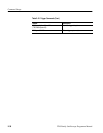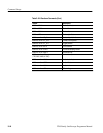
Command Groups
TDS Family Oscilloscope Programmer Manual
2–39
values range from 0 to 255. When the byte width is two, the values range from
–32768 to 32767.
The defined binary formats also specify the order in which the bytes are
transferred. The four binary formats are RIBinary, RPBinary, SRIbinary, and
SRPbinary.
RIBinary is signed integer where the most significant byte is transferred first,
and RPBinary is positive integer where the most significant byte is transferred
first. SRIbinary and SRPbinary correspond to RIBinary and RPBinary respec-
tively but use a swapped byte order where the least significant byte is transferred
first. The byte order is ignored when DATa:WIDth is set to 1.
You can transfer multiple points for each waveform record. You can transfer a
portion of the waveform or you can transfer the entire record. The DATa:STARt
and DATa:STOP commands let you specify the first and last data points of the
waveform record.
When transferring data into the digitizing oscilloscope, you must specify the
location of the first data point within the waveform record. For example, when
you set DATa:STARt to 1, data points will be stored starting with the first point
in the record, and when you set DATa:STARt to 500, data will be stored starting
at the 500
th
point in the record. The digitizing oscilloscope will ignore
DATa:STOP when reading in data as it will stop reading data when it has no
more data to read or when it has reached the specified record length.
When transferring data from the digitizing oscilloscope, you must specify the
first and last data points in the waveform record. Setting DATa:STARt to 1 and
DATa:STOP to the record length will always return the entire waveform. You can
also use the vertical bar cursors to delimit the portion of the waveform that you
want to transfer. DATa:STARt and DATa:STOP can then be set to the current
cursor positions by sending the command DATa SNAp.
The DATa:SOUrce command specifies the data location when transferring
waveforms from the digitizing oscilloscope. You can transfer out multiple
waveforms at one time by specifying more than one source.
You can transfer in to the digitizing oscilloscope only one waveform at a time.
Waveforms sent to the oscilloscope are always stored in one of the four reference
memory locations. You can specify the reference memory location with the
DATa:DESTination command. You must define the memory size for the
specified location before you store the data. The ALLOcate:
WAVEFORM:REF<x> command lets you specify the memory size for each
reference location.
Waveform Data/Record
Lengths
Waveform Data Locations
and Memory Allocation


















